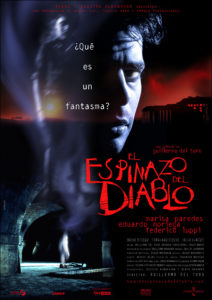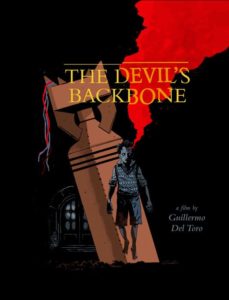 “What is a ghost? A tragedy condemned to repeat itself time and again? A moment of pain, perhaps. Something dead which still seems to be alive. An emotion suspended in time. Like a blurred photograph. Like an insect trapped in amber.” – Opening of “The Devil’s Backbone.”
“What is a ghost? A tragedy condemned to repeat itself time and again? A moment of pain, perhaps. Something dead which still seems to be alive. An emotion suspended in time. Like a blurred photograph. Like an insect trapped in amber.” – Opening of “The Devil’s Backbone.”
One of my favorite directors, even before I got into Spanish films, is Guillermo del Toro. Before his major break with Pan’s Labyrinth in 2006 (and more recently, The Shape of Water in 2017), he was best known for his horror films. The Devil’s Backbone (El espinazo del diablo) is one of his most personal films, not only because it followed the absolute disaster of filming Mimic, but because the script builds off his core themes as a filmmaker. This 2001 gothic horror film explores the nature of ghosts and repetition.
The film is set in Spain in the year 1939, during the final year of the Spanish Civil War, at an orphanage on the outskirts of a small town. The protagonist is the newly orphaned Carlos, whose father died fighting on the side of the Republicans against the fascist Nationalist forces led by Francisco Franco. The headmistress who has lost a leg to the fighting, Carmen, and Dr. Casares, the orphanage doctor, are secretly hiding a large cache of gold for the Republicans. Carlos soon begins to have haunting visions of a boy named Santi who died the same night a bomb was dropped on the orphanage but miraculously did not go off (though it is said you can still hear it ticking). His troubles are further complicated when he learns the sadistic caretaker of the orphanage, Jacinto, is plotting to steal the gold and will do anything to get it.
 One thing that has been present throughout Del Toro’s career has been his ability to mix fantasy with brutal reality. The film is defined by the literal and metaphorical ghosts within and outside of the orphanage. For those not familiar with Spanish history, the Republicans lose. Everyone is bound to the fate of the Republican cause, either as an orphan of a fallen soldier or their caretakers. It is set to be a tragedy from the start. Besides these political constraints, every character is haunted by something that keeps them locked in their course in life. When watching the film, I want you to ask yourself: What is haunting this character? What are they haunting? Is exorcism possible on a personal or national level, or are things doomed to repeat themselves time and again?
One thing that has been present throughout Del Toro’s career has been his ability to mix fantasy with brutal reality. The film is defined by the literal and metaphorical ghosts within and outside of the orphanage. For those not familiar with Spanish history, the Republicans lose. Everyone is bound to the fate of the Republican cause, either as an orphan of a fallen soldier or their caretakers. It is set to be a tragedy from the start. Besides these political constraints, every character is haunted by something that keeps them locked in their course in life. When watching the film, I want you to ask yourself: What is haunting this character? What are they haunting? Is exorcism possible on a personal or national level, or are things doomed to repeat themselves time and again?
Besides the excellent writing and directing from del Toro, my favorite aspect of the film is the set. The old school stranded in the desert makes for a personal, claustrophobic stage, perfect for drama and terror. The most prominent set piece in the film is the defused bomb that haunts the courtyard, constantly reminding the viewer of the wider conflict. The casting was also very effective and dodged many of the problems that come with using child actors. The performance of Eduardo Noriega made Jacito especially menacing. While the budget was only 4.5 million, the director, actors, and production crew clearly put a lot of (fake?) blood, sweat, and tears into this project.
If you’re interested in horror or magical realism, I highly recommend this film. A great movie to follow it up with is Pan’s Labyrinth, which is set five years after the war under the Francisco Franco regime and revisits many of the same themes, though with a more fantastic bend and a bit more hope. If ghost stories don’t usually scare you, remember: Who needs ghosts when you have other people?
For more information on the film, check out this comprehensive article from Cinephilia & Beyond.
